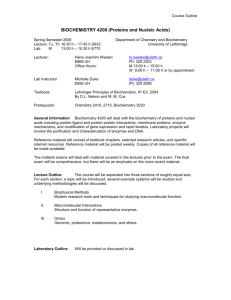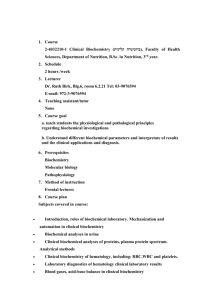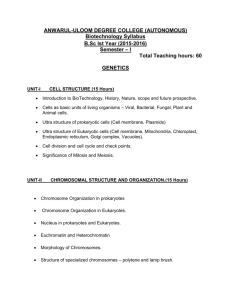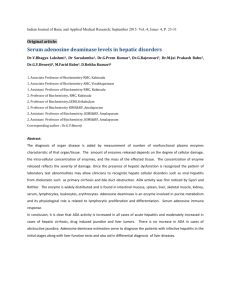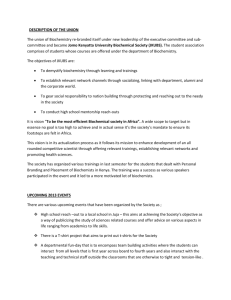Click Here for More Details - Dayal Institute of Science
advertisement
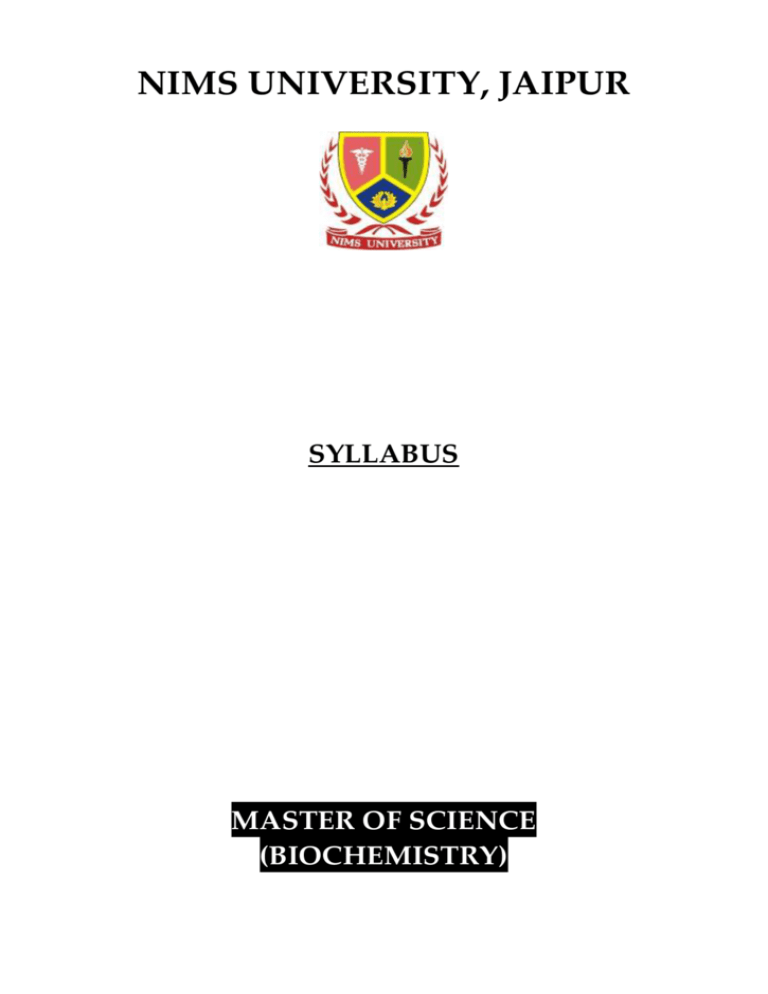
NIMS UNIVERSITY, JAIPUR
SYLLABUS
MASTER OF SCIENCE
(BIOCHEMISTRY)
NIMS UNIVERSITY, JAIPUR
MASTER OF SCIENCE (BIOCHEMISTRY)
COURSE STRUCTURE AND EXAMINATION SCHEME
M. Sc. (Biochemistry) degree program will comprise of four semesters. Candidates will be
evaluated after each semester. Final theory examination of 50 marks, assessment of 20 marks and
practical of 30 marks in each paper will be conducted at the end of the semester. Each theory paper
will have six questions and the candidate will have to attempt five questions. However, each question
except question No.1 will have two choices. Question No.1 will be compulsory and will have
objective type questions from all the units. Sessional of 20 marks will be the total of two sessional
examinations each of theory. One seminar carrying 50 marks will be delivered each year by the
student.
Dissertation: The project work will involve indepth practical work on a problem suggested
by the supervisor of the student. The student will submit the results of the work done in the form of
dissertation to the head of the department in the fourth semester. The dissertation will carry 200
marks. The dissertation submitted by the student will be evaluated by one external expert, head of the
department and supervisor of the student. The dissertation examination will be held in the
department and the dissertation will not be mailed to the external examiner.
Minimum pass marks will be 40% in theory and 40% in practical and 50% in aggregate.
M.Sc. Biochemistry
First Year
Distribution of Marks
Theory Practical Internal
Total
1. General Biochemistry
50
30
20
100
2. Molecular Biology and Microbial
Genetics
50
30
20
100
3. General Microbiology
50
30
20
100
4. Enzymology
80
-
20
100
5. Plant Biochemistry
80
-
20
100
6. Intermediary Metabolism
80
-
20
100
7. Biochemical Techniques
80
-
20
100
8. Food Chemistry
50
30
20
100
9. Biomolecules
50
30
20
100
10. Applied Biotechnology
50
30
20
100
1
NIMS UNIVERSITY, JAIPUR
MASTER OF SCIENCE (BIOCHEMISTRY)
M.Sc. Biochemistry
Second Year
Distribution of Marks
Theory Practical Internal
Total
1. Immunology
50
30
20
100
2. Food & Nutritional Biochemistry
50
30
20
100
3. Biostatistics & Computer
Application
80
-
20
100
4. Bioinformatics & Intellectual
Property Right
80
-
20
100
5. Animal Cell Science & Technology
50
30
20
100
6. Immuno Biochemistry
50
30
20
100
7. Medical Biochemistry
80
-
20
100
8. Dissertation
-
-
-
200
2
NIMS UNIVERSITY, JAIPUR
MASTER OF SCIENCE (BIOCHEMISTRY)
GENERAL BIOCHEMISTRY
UNIT-I
Biophysical properties of molecules, cell, sub-cellular organelles, transport across cell
membrane, biological oxidation-reduction, bioenergetics and oxidative phosphorylation.
UNIT-II
Enzyme, coenzyme and inhibitors, fat and water-soluble vitamims, structure and properties
of amino acids, properties and biological significance of proteins.
UNIT-III
Biological role of lipids, saturated and unsaturated fatty acids, plant growth substances,
biological membranes, plant and animal pigments.
UNIT-IV
Replication, transcription and translation. Introduction to recombinant DNA technology,
major metabolic pathways of Carbohydrates, Proteins And Lipids, Biological Nitrogen Fixation.
UNIT-V
Photo synthesis and photo respiration . Nutritional aspects of carbohydrate, proteins Fats,
Minerals and Vitamins.
Practical:
1.
2.
Color reactions of carbohydrates, proteins and fats. Determination of reducing, non-reducing and
total sugars.
Protein estimation by Lowry method, amylase assay in human saliva.
Books:
1.
2.
3.
4.
Outlines of Biochemistry: Conn, E.E, Stumpf, P.K Bruening, G and Doi, R.H. John Wiley and sons
Inc, New York and Toranto.
Biochemistry: Styer, L. Freeman WH and company, New York.
Fundamentals of Biochemistry: Voet &Voet, PraH, CW John Wiley and Sons Inc, New York and
Toranto.
Biochemistry: Zubay G.L, W.C. Brown Publishers.
3
NIMS UNIVERSITY, JAIPUR
MASTER OF SCIENCE (BIOCHEMISTRY)
MOLECULAR BIOLOGY AND MICROBIAL GENETICS
Unit- I
Nucleic acid as genetic information carriers: historical aspects and current concepts, melting
of DNA. DNA replication: modes of replications, isolation and properties of DNA polymerases, proof
reading, continuous and discontinuous synthesis. Asymmetric and dimeric nature of DNA
polymerase III and simultaneous synthesis of leading and lagging strands, DNA polymerase,
exonuclease activity in eukaryotes. Superhelicity in DNA, topological properties, mechanism of action
of topoisomerases. Replication of single stranded DNA. Construction of replication form in test tube.
Retroviruses and their unique mode of DNA synthesis. Relationship between cell cycle and
replication. Inhibitors of DNA replication. DNA damage and repair: types of DNA damage
(delamination, oxidative damage, alkylation, pyrimidine dimers). Repair pathways: methyl directed
mismatch pair, very short patch repair, nucleotide excision repair, base excision repair, recombination
repair and SOS repair.
Unit- II
Structural features of RNA (r RNA, tRNA and mRNA) and relation to function.Initiator and
corresponding site on rRNA, peptidyl transferase activity of 23S rRNA. Transcription: general
principles, types of RNA Polymerases, steps: initiation, elongation and termination, inhibitors of RNA
synthesis. Polycistronic and monocistronic RNAs. Control of transcription by interaction between
RNA polymerases and promoter regions, use of alternate sigma factors, controlled termination:
attenuation and antitermination. Regulation of gene expression: operon concept, catabolite
repression, instability of bacterial RNA, positive and negative regulation, lac operon, positive and
negative regulation. DNA binding proteins, enhancer sequences and control of transcription.
Identification of protein – binding sites on DNA. Global regulatory responses: heat shock response,
stringent response and regulation by ppGpp and cAMP, regulation of rRNA and tRNA synthesis.
Regulation of nitrogen assimilation.
Unit- III
Maturation and processing of RNA: methylation, cutting and trimming of rRNA; capping,
polyadenylation and splicing of mRNA; cutting and modification of tRNA capping, cutting and
modification of tRNA degradation system. Catalytic RNA, group I and group II intro splicing, RNase
P., Genetic code, Protein synthesis: initiation, elongation and termination, role of various factors,
inhibitors of protein synthesis. Synthesis of exported proteins on membrane bound ribosomes, signal
hypothesis. In vitro transcription and translation systems.
Unit- IV
Gene as unit of mutation and recombination. Molecular nature of mutations and mutagens.
Spontaneous and induced mutation.Gene transfer mechanism – transformation, transduction,
conjugation and transfection.Mechanisms and applications. Genetic analysis of microbes, bacteria and
yeast.
Unit- V
Plasmids, F-factors description and their uses in genetic analysis. Colicins and col factors.
Plasmids as vectors for gene cloning. Replication of selected plasmids: compatibility. Jumping genes
and their uses in genetic analysis
Practicals
1.
2.
3.
4.
5.
To study spontaneous mutations by replica plating.
To study induced mutation in bacteria.
Isolation of antibiotic resistant mutants by gradient plate technique.
Isolation of antibiotic resistant mutants by antibiotic disc method.
To study bacterial variations.
4
NIMS UNIVERSITY, JAIPUR
6.
MASTER OF SCIENCE (BIOCHEMISTRY)
Ames test.
Books:
1.
Bacterial Genomes 1998. De Brujin et al. Chapman & Hall.
2.
Genetics of Bacterial Virulence Dorman C. J. 1994. Blackwell.
3.
Genome Analysis. Four volumes 2000. CSH publications.
4.
Molecular cloning. 3 volumes. Ambrose And Russell. 2000. CSH press.
5.
Principles of Gene Manipulation. 1994 Old & Blackwell Scientific Pulication.
6.
Gene VII. Lewin (Oxford University press) 2000.
7.
Microbial Genetics. Maloy et al. 1994. Jones & Bertiett Publishers.
8.
Modern microbial genetics.1991 & Yasbin, Niley Ltd.
9.
Molecular Genetics of Bacteria. J.W. Dale. 1994. John Wiley& Sones.
10. Molecular Genetics of Bacteria- Larry Synder & Wendy Champness.
11. Molecular Cell Biology (W.H. Freeman by Lodish, Berk, Zippursky).
5
NIMS UNIVERSITY, JAIPUR
MASTER OF SCIENCE (BIOCHEMISTRY)
GENERAL MICROBIOLOGY
Unit- I
History, development and scope of Microbiology. Distinctive characters of major groups:
Prions, Viruses, Bacteria, Fungi, Algae and Protozoa. Microscopy
Unit- II
Morphology and ultra structure of bacteria: morphological types, cell walls of archeabacteria,
Gram negative, Gram positive eubacteria. Eukaryotes, L- forms: cell wall synthesis, antigenic
properties- capsule type composition and function. Structure and function of cell membrane. Flagella,
cilia, chromosomes, carboxysomes, magnetosomes, phycobolisomes, nucleid: endosporemorphology, physiology and formation. Reserve food material, cytoplasmic inclusions.
Unit- III
Cultivation of bacteria- aerobic, anaerobic culture techniques, culture media. Growth curvegeneration time, growth kinetics, batch and continuous culture, growth measurements, factors
affecting growth; maintenance and preservation of microbial culture. Control of microbes- physical
and chemical methods. Types of bacteria on basis of energy and nutritional requirement.
Unit- IV
Classification of microorganisms: haeckel’ s three kingdoms concept- Whittaker’s five
kingdoms concept, three domain concept of Carl Woese, Modern trends in classification. Ribotyping,
nucleic acid hybridization, RNA fingerprinting, molecular chromometer. Classification and salient
features of bacteria according to the Bergey’s manual of systematic bacteriology.
Unit- V
Archeabacteria: Methanotrophs, halophiles and sulphur dependent archeabacteria - Gram
negative bacteria; spirochetes, aerobic or microaerophilic rods and cocci. Facultative aerobes,
anaerobes, Rickettsia and Chlamydia, anoxygenics and oxygenic phototrophs, gliding bacteria,
sheathed bacteria, budding and appendaged bacteria chemolitotrophs- Gram positive cocci and rods,
endospore forming rods, mycobacteria and actinomycetes.
Practicals
1.
Preparation of culture media – Liquid & Solid media, Enrichment, Selective & Differential media.
Preparation of slant & deep tube culture.
2.
Isolation of pure culture by Pour plate, Serial dilution and Streak plate method.
3.
Study of growth curve.
4.
Effect of pH, temperature, osmolarity & oxygen, UV, Desiccation on bacteria.
5.
Cultivation of Anaerobic organisms.
6.
Sterilization methods.
7.
Methods of quantitative estimation of microorganisms(a) Total Count-Haemocytometer (b)Viable
Count- Plate Count.
8.
Methods of staining bacteria
9.
Simple staining
10. Gram staining
11. Endospore staining
12. Negative staining
13. Flagella staining
14. Cell Wall staining
6
NIMS UNIVERSITY, JAIPUR
MASTER OF SCIENCE (BIOCHEMISTRY)
Books
1.
Brock TD, Madigan MT,(1993) Biology of microorganisms. Prentice Hall Int. Inc.
2.
Ananthanarayanan R. and C. K. Jayaram Paniker (1997) Text of microbiology, Orient Longman.
3.
Hewitt, W. (1974): Microbiological Assay. Academic Press, New York.
4.
Wardlaw, A.C. (1982): (I) Four Point parallel line assay Penicillin pp. 370-379. (II) Microbiological
assay of a Vitamin- nicotinic acid. pp. 214-233. In. S. B. Primrose and A.C. Warrdlaw (Eds)
Sourcebook, Source book of Experiments for the Teaching of Microbiology. Academic press,
London and New York.
5.
Henderson et al. (1999) Cellular Microbiology. Wiley.
6.
Brunn, Y.V. and Shimkets, L.J. (2000) Prokaroyotic Development. ASM Press.
7.
Stanier RY, Ingraham JL, Wheelis, ML Painter PR (1986).General Microbiology
8.
Topley & Wilson’s (1995) Text book on principles of bacteriology, virology
ed. Edward Arnold, London.
9.
Michael J. Pelczar JR et al. (1993) Microbiology: Concepts and Applications, Mc Graw- Hill. Inc.
(ISBN. 0- 07- 049258-1).
10. Prescott Harley Klein:(1996) Microbiology III ed. ECB Pub.
11. Nester E. W. et al; Microbiology Sauders college Pub.
7
& immunology IX
NIMS UNIVERSITY, JAIPUR
MASTER OF SCIENCE (BIOCHEMISTRY)
ENZYMOLOGY
Unit-I
Enzyme, nomenclature and classification, enzyme compartmentalization in cell organelles,
isolation and purification of enzymes, measurement of enzyme activity.
Unit-II
Enzyme structure, cofactors, coenzymes- their structures and role, active site, enzyme
specificity, mechanism of enzyme catalysis
Unit-III
Enzyme kinetics, enzyme inhibition, and activation, multienzyme complexes.
Unit-IV
Ribozyme, abzymes, allosteric enzymes and their kinetics, regulation of enzyme activity,
active site mapping.
Unit-V
Enzyme immobilization, application of enzymes in chemical and food industry, biosensors
and clinical application of enzymes, enzyme therapy, detoxifying enzyme.
Practicals
Isolation, purification, assay and kinetics of some enzymes from plants, animals and
microorganisms namely amylase, peroxidase, catalase and phosphatase etc.
Books:
1.
Enzymes- Dixon, Weble, E.C Throne, K.F Langman, London.
2.
Fundamentals of Enzymology- Price, NC and Sterens L, Oxford University Press, Oxford.
3.
Methods of Enzymatic Analysis- Bergmeyer, H.U Vol-II Verlag Chemic, Weinhem, Academic
Press, New York and London.
4.
Biochemical Calculations- Irwin M. Segel, John Wiley and Sons, Inc. New York
8
NIMS UNIVERSITY, JAIPUR
MASTER OF SCIENCE (BIOCHEMISTRY)
PLANT BIOCHEMISTRY
Unit-I
Scope and importance of biochemistry in plant.
Unit-II
Dark respiration, photosynthesis and photorespiration, regulation of carbon metabolism,
nitrogen cycle, symbiotic and asymbiotic nitrogen fixation, genetics and mechanism of nitrogen
fixation, uptake hydrogenase.
Unit-III
Ammonia and sulfate assimilation, denitrification, and chemoautotrophy, biosynthesis of
carbohydrates, lipids, proteins.
Unit-IV
Biochemical autonomy of chloroplasts, chemical composition and biosynthesis of plant cell
wall, biosynthesis and role of secondary metabolites.
Unit-V
Plant hormones and their molecular mechanism of action, signal transduction mechanism in
plants, toxic principles, pest and disease resistance.
Books:
1.
Plant Biochemistry- Dey, PM and Harborne, J.B Academic Press.
2.
Plant Biochemistry and Molecular Biology- Heldt, H.W. Oxford University, Press.
3.
Plant biochemistry and Molecular Biology- Lea, P.S and Leegood, L.C John Wiley and Sons, Inc.,
New York.
9
NIMS UNIVERSITY, JAIPUR
MASTER OF SCIENCE (BIOCHEMISTRY)
INTERMEDIARY METABOLISM
Unit-I
Introduction to metabolism, methods of studying metabolism, bioenergetics, biological
oxidation- reduction.
Unit-II
Energy transduction and oxidative phosphorylation, catabolic and anabolic pathways of
carbohydrates, lipids, amino acids, proteins, and nucleic acids.
Unit-III
Metabolic disorders, cellular and organelle compartmentation of metabolic pathways.
Unit-IV
Metabolic profiles of major organs and regulation of metabolic pathways.
Books:
1.
Lehninger Principles of Biochemistry- David L, Nelson & Cox.
2.
Text of Biochemistry for Medical Students- AVSS Rama Rao and Shraya laxmi.
3.
Outlines of Biochemistry- Conn EE, Stupf, P.K Bruening G and Doi RH John Wiley and Sons Inc,
New York and Toranto.
4.
Harper’s illustrated Biochemistry-R K Murray, Darylk Granner and Victor W Road Well
5.
Biochemistry Stryer, L- W H Freeman and Company, New York.
10
NIMS UNIVERSITY, JAIPUR
MASTER OF SCIENCE (BIOCHEMISTRY)
BIOCHEMICAL TECHNIQUES
Unit-I
Preparation of solutions and buffers, spectroscopy and fluorometry.
Unit-II
Quantitative estimation of carbohydrates, amino acids, proteins, lipids and vitamins in
biological materials
Unit-III
Separation techniques, centrifugation, paper thin layer and colum chromatography,
electrophoresis, isolation and assay of enzymes.
Unit-IV
Simple enzyme kinetics, isolation and quantitative estimation of DNA and RNA.
Unit-V
Use of radioisotopes in metabolic studies, ELISA, RIA, Autoradiography.
Books:
1.
An introduction to Practical Biochemistry- D.J. Plummer, Tata Mc Graw Hill,
Company Ltd., New Delhi
2.
Principles and Techniques of Practical Biochemistry- Wilson and Walker,
3.
J. Cambridge University Press, U.K.
4.
A Manual of Laboratory Techniques – N. Raghuramulu, K Madhavan, Nair, S. Kalyanasundaram,
National Institute of Nutrition, ICMR Hyderabad, India.
5.
Standard methods of Biochemical Analysis- S.R Thimmaiah, Kalyani Publishers, New Delhi,
India
11
Publishing
NIMS UNIVERSITY, JAIPUR
MASTER OF SCIENCE (BIOCHEMISTRY)
FOOD CHEMISTRY
Unit- I
Chemistry of carbohydrates, fats, proteins and vitamins, oxidative rancidity, enzymatic and
non enzymatic browning.
Unit- II
Chemical composition of foods, anti nutrients, nutritive and supplementary value of different
foods (plant, dairy, poultry etc.)
Unit- III
Biochemical aspects of post-harvest storage, preservation and processing, metabolism of
additives, antioxidant and synergists.
Unit- IV
Biochemistry of food spoilage and deterioration, enzymes in food industry.
Practical:
Proximate analysis of foods namely proteins, fats, ash, crude fiber, vitamins, minerals (Ca, P,
Fe), analysis of major anti-nutrients, use of enzymes in food analysis.
Books:
1.
Foods that harm, Food that heal-AMC Whirta, The Reader Digest Association Limited London.
2.
Food Science, NN Potter, JH Hotch Kiss, CBS Publishing and distributors, New Delhi, India.
3.
Food Chemistry L.H Meyer, CBS Publishing and distributors, Delhi, India.
4.
Food, Facts and Principles,N S Many, M Shadak-Sharaswamy, New Age International (P) Ltd.
Publishers, Banglore, India.
12
NIMS UNIVERSITY, JAIPUR
MASTER OF SCIENCE (BIOCHEMISTRY)
BIOMOLECULES
Unit-I
Principles of thermodynamics, I & II law of thermodynamics, concept of free energy, high
energy compounds, Carbohydrate-classification and properties, carbohydrate metabolismglycogenolysis, TCA cycle, pyruvate oxidation, phosphorylation and photophospho-rylation,
biosynthesis of starch, sucrose, glycogen and cellulose.
Unit-II
Classification of aminoacids, peptide bonds, peptides and polypepyides. Classification of
protein and heirachy in its structure(primary, secondary, quaternary), Ramachandran map, Amino
acid metabolism- oxidation of amino acid,Protein in biological membrane, Chemical synthesis of
peptides, synthesis and mode of action of insulin.
Unit-III
Lipids: Classification, chemistry and properties, fatty acids metabolism, biosynthesis of fatty
acids, triglycerides, phospholipids and cholesterol. Degration of fatty acids, prostaglandin. Lipid in
biological membrane.
Unit-IV
Pyrimidine and purine bases- nucleosides and nucleotides, structure of DNA, types of
DNA,RNA their structure and functions, metabolism- purine and pyrimidine bio-synthesis,
porphyrin biosynthesis, vitamins- fat and water soluble, synthesis of nucleotides.
Unit-V
Enzymes; classification acc.to IUB,enzyme kinetics, Michaelis Menten equation, km value,
kinetics of bi-bi substrate reaction, enzyme inhibition, regulation of enzyme activity, feedback
inhibition, allosteric control, enzyme catalysis in solution, effect of organic solvents on enzyme
catalysis, immobilization of enzymes and its application, determination of the active sites and amino
acid present. Coenzyme-structure, function and reactions(TPP, pyridoxal, phosphate, nicotinamide,
flavin nucleotide, coenzyme A, biotin, vitamin K).Clinical and industrial application of enzymes,
enzyme engineering.
Practical:
1.
Isolation, purity determination and quantitation of cholesterol, DNA and RNA.
2.
Electrophoresis of protein- native and under denaturing conditions.
3.
Electrophoresis of DNA-linear, circular and supercoiled.
4.
N and C- terminal analysis of proteins.
5.
Peptide mapping.
6.
Quantitative anlysis of proteins and sugars.
7.
Determination of iodine number, saponification value, acid value of oil.
8.
Enzyme: Purification and kinetic analysis.
Books:
1.
Biochemical Calculations, Irwin H. Segel, John Wiley and Sons Inc. New York.
2.
Biochemistry, D. Voet and J.G.Voet, J. Wilry and Sons, Inc, New York.
3.
A Biologist’s Guide to Principles and Techniques of Practical Biochemistry, K. Wilson and K.H.
Goulding, Cambridge University, Press, UK.
4.
Outlines of Biochemistry-Conn EE, Stumff, P.K Bruening G and Doi RH, John Wiley and Sons,Inc,
New York and Toronto.
5.
Biochemistry: Stryer, L. Freeman, W. H. Company, New York.
13
NIMS UNIVERSITY, JAIPUR
MASTER OF SCIENCE (BIOCHEMISTRY)
APPLIED BIOTECHNOLOGY
Unit-I
Agri-biotechnology: Cloning by tissue culture, Improvement of animal breeds, Improvement
of cultivars by plant genetic engineering. Soil biotechnology: Improving soil bioprocesses for plant
nutrient conservation, carbon conservation and sequestering. Harnessing more N 2 fixation and
biofertilizers. Better understanding of plant- microbe relation including host plant and pathogen.
Improving quality of biopesticides.
Unit-II
Biotechnology in medicine: Drug discovery, creating pharmaceuticals through combinatorial
chemistry, through peptide and DNA synthesis through protein or antibody engineering, in vitro
fertilization & related techniques. Introduction to Pharmaco-genomics.
Unit-III
Making DNA molecule: DNA synthesis products, PCR application. Application biotechnological tools in forensic science. Transcriptome: Determining DNA sequences, Whole genome
short gun sequencing, Genome annotation, functional genomics, open reading frame (ORF), coding
sequences (COS), Para logs, Orthologs. Evaluations of RNA level gene expression, Microarray
analysis. Gene chips, motif, spotted arrays expressed sequence tags (ESTs), comparative genomics,
horizontal gene transfer (HGT).
Unit-IV
Biotechnology in industry and information technology. Introduction to Nanotechnology.
Proteomics: Proteome, definition of proteomics, functional proteomics, structural protein two
dimensional electrophoresis. Identification of genes with unknown proteins, genomic analysis of
pathogens, extremophiles, environmental genomics, metagenomics. Construction of genomic libraries
directly from environment, hierarchical cluster analysis of gene expression following exposure to Y
radiations.
Unit-V
Environmental biotechnology for improvement of environment and quality of food. Leather
processing, Enzymes & microbiological treatment of oil industrial wastes for biogas production.
Bioprocessing of solid waste. Biotechnological approach for energy production from municipal waste,
composting bioremediation in aquacultures & removal of heavy metals.
Practicals:
1.
2.
3.
4.
5.
Isolation of nitrogen fixing bacteria ( Rhizobium, Azotobacter, Azospirilum etc )
Measurement of Nitrogen fixing ability.
Isolation of phosphate solubilising organism
Testing for phosphate solubilizers.
Transfection of E. coli with M 13 Phage DNA.
Books:
1.
2.
3.
4.
5.
6.
7.
8.
9.
Introductions to Biodeterioration, D. Allsopp and K.J. Seal, ELBS/Edward Arnold.
Bioremederation Engineering: Design and Application, J.T. Cookson, McGraw Hill, Inc.
Biotechnology for waste and waste water treatment, Cheremisin off Nicholas P.
Comprehensive Biotechnology, Vol. 4. M. Moo-Yound (Edin-chief), Pergamon Press, Oxford.
Bioinformatics 2000. Higgins & Taylor. OUP.
Elements of Biotechnology, P.K. Gupta, Rastogi and Co. Meerut, 1996.
Molecular Cloning: a Laboratory Manual, J. Sambrook, E.F. Fritsch and T. Maniatis, Cold Spring
Harbor Laboratory Press, New York, 2000.
DNA Cloning: A Practical approach, D.M.Glove and B.D. Hames. IRL Press Qxford, 1995.
Molecular and Cellular Methods in Biology and Medicine, P.D. Kaufman. W Wu.. D. Kim and
L.J.: Cseke, CRC Press. Florida. 1995.
14
NIMS UNIVERSITY, JAIPUR
MASTER OF SCIENCE (BIOCHEMISTRY)
IMMUNOLOGY
Unit- I
Historical background: Humoral and cellular immunity. Innate immunity: skin and mucosal
surface, Physiological barriers, Phagocytic barriers, inflammation and adaptive immunity. Immune
dysfunction and its consequences; allergy and asthma.
Cells and organs of immune system: Lymphoid cells, stem cells, B and T Lymphocytes,
Natural Killer cells, mononuclear phagocytes, granulocytic cells.
Organs: Thymus, Bone marrow, Lymphatic system, Lymph nodes, spleen.
Unit- II
Antigens and antibodies: Antigens; Structure, properties, types, epitopes, haptens.
Antibodies; structure and function, antibody mediated functions.Antibody classes and biological
activities. Monoclonal antibody. Antigen antibody interactions: Precipitation reaction, agglutination,
radioimmunoassay, ELISA, Immuno blotting, western blotting. Major histocompatibility Complex :
General structure and function of MHC, MHC molecules and genes, antigen processing and
presentation, T cell receptors, T cell maturation and differentiation, B cell generation, activation and
differentiation .
Unit- III
Immune effecter mechanism: Cytokinesis (Properties, receptors, antagonists and secretion).
The compliment system (Functions, components, activation, regulation and deficiencies). Cell
mediated effector responses: cytotoxic T cells, Natural killer cells, and Antibody dependent cell
mediated cytotoxicity. Inflammation. Hypersensitive reactions (Type I, II, III and delayed type
{DTH}).
Unit- IV
Immunology in health and disease: Immune responses to infectious diseases: Viral, bacterial
and protozoan. AIDS and other Immuno deficiencies. Vaccines, Genetically designed vaccines, BCG,
TB, Leprosy, DNA vaccines.
Unit- V
Transplantation and auto immunity: Organ specific autoimmune diseases, Systemic auto
immune diseases. Graft rejection, evidence and mechanism of graft rejection, prevention of graft
rejection, immunosuppressive drugs, HLA and disease, mechanism of immunity to tumor antigens.
Autoantibodies in human pathogenic mechanism, experimental models of autoimmune disease
treatment of autoimmune disorders.
Practicals:
1.
Radio-immunodiffusion.
2.
Immuno-electrophoresis
3.
Dot ELISA.
4.
Ouchterlony Double diffusion.
5.
Quantitative precipitin Assay.
6.
Widal test.
7.
Sandwich ELISA
8.
Latex Agglutination.
15
NIMS UNIVERSITY, JAIPUR
MASTER OF SCIENCE (BIOCHEMISTRY)
Books:
1.
Immunology A Short course, Benjamin E and Leskowitz S., Wiley Liss NY to 1991.
2.
Immunology- Understanding of Immune System Klans D. Elgret (1996). Wiley- Liss, NY.
3.
Kuby J. Immunology IIed. (1994) W.H. Freeman & Co. NY.
4.
Pravesh C. Sen Gupta, Clinical Immunology, Oxford India, 2003(II Vol).
5.
Richard A. Goldshy et al. Immunology 5 th ed. W.H. Freeman & Co. NY 2003.
6.
Roitt I, Essential Immunology, Blackwell Se Pub. Oxford. III ed.
7.
Topley & wilson’s (1995) Text book on principles of bacteriology, Virology & Immunology IX
ed. Edward Arnold, London.
16
NIMS UNIVERSITY, JAIPUR
MASTER OF SCIENCE (BIOCHEMISTRY)
FOOD AND NUTRITIONAL BIOCHEMISTRY
Unit-I
Physiochemical, functional and nutritional characteristic.
Unit-II
Carbohydrate, proteins, fats and their interactions(emulsions, gelation, browning etc.)
biochemical and nutritional aspects of vitamins, minerals, antinutritional factor, biochemistry of post
harvest storage.
Unit-III
Effect of cooking, processing and preservation of different food, products on nutrients,
biochemical aspects of food spoilage.
Unit-IV
Oxidative rancidity and anti oxidants, Enzymes in food industry, food additives (colouring
agent, preservatives etc.)
Unit-V
Biogenesis of food flavours and aroma, nutritional quality of plant, dairy, poultry and marine
products.
Practical:
Determination of proximate composition of major nutrients in food (proteins, lipids,
carbohydrates, minerals),determination of antinutritional factors such as phytate, trypsin, inhibitors
in food; digestibility of proteins and fractionation of storage proteins in cereals and legumes;
determination of amino acid, composition of food proteins.
Books
1.
Nutrional Biochemistry and Metabolism- Linder
2.
Food Chemistry-Fenema
3.
Biochemistry of Foods-Eskin et al
4.
Food Biotechnology-Knorr
5.
Practical Biochemistry-Sharm S. Classic Publishing House, Jaipur, India.
6.
Nutritive value of Indian Foods- Rao, BSN, Deosthale, Y.G and Pant, KC, National Institute of
Nutrition, ICMR, Hyderabad, India.
17
NIMS UNIVERSITY, JAIPUR
MASTER OF SCIENCE (BIOCHEMISTRY)
BIOSTATISTICS AND COMPUTER APPLICATION
Unit-I
Importance and scope in biological experiments. Brief description of tabulation of data and
their graphical representation. Measures of central tendency. Arithmetic, Geometric and Harmonic
Means, Median, Mode. Measures of dispersion : Range, Quartile- deviation, Variance. Elementary
idea of Probability : Mathematical, Axiomatic and Statistical definitions, addition and multiplication.
Probability distribution, definition and application: Binomial, Poisson, Normal distributions
definitions and its application.
Unit-II
Simple linear regression and correlation, Relation between two variables. Linear Regression :
diagrams and equation, significance test, prediction of dependent variable from independent one.
Linear Correlation: scatter diagrams, correlation coefficient, standard error. Relationship between
correlation and regression coefficient.
Unit-III
Elementary idea of random sampling, selection of simple random samples from a finite
population. Methods of sampling, definition of sampling distribution, sampling variance and
standard error. Test of significance: Normal deviate tests (Z Test), Students T test, Chi square test, F
test. Analysis of Variance : One way classification with equal and unequal sample sizes, two way
classification with one observation per cell. Completely Randomized Design, Multiple Comparisons
Isd and Duncan’s New Multiple Range test. Introduction to 2 Factorial Design.
Unit-IV
Computer Application : Introduction to computer science. Computers and their
organizations, hardware, software, operating system (Command and WIMP). Introductions to
Windows: Windows application (Microsoft Word, Excel, PowerPoint and Multimedia).
Unit-V
Introduction to Internet (LAN, MAN, WAN) and use of electronic mail. Elementary idea
about programming and presentation (Spread Sheet and Statistical Analysis).Computer Aided
Learning in Biotechnology.
Books
1.
Programming in C, E. Balaguru Swamy.
2.
C++ from scratch, J. Liberty.s
3.
How computer work, 2000, Ron White, Techmedia.
4.
How internet works, 2000, Preston Gralla, Techmedia.
5.
Bioinformatics 1998, Baxevanis.
6.
Bioinformatics 2000, Higgins and Taylor, OUP.
7.
Nucleic Acids Research, 2001, Jan. Genome Database issue.
8.
Statistics in Biology, Bliss, C.I.K (167): Vol. 1, McGraw Hill, New York.
9.
Statistics for Biologists by Campbell R. C. (1974): Cambridge University Press, Cambridge.
10. Statistical Methods as Applied to Immunological data, app. 1163-1206. In D.M. Weir (Ed/) Handbook ‘Experimental Immunology’, Lutz, W. (1967), Blackwell Publication. Ltd., Oxford.
11. Practical Statistics for experimental Biologist, Wardlaw, A.C. (1985), John Wily and Sons., Inc.
New York.
18
NIMS UNIVERSITY, JAIPUR
MASTER OF SCIENCE (BIOCHEMISTRY)
BIOINFORMATICS AND INTELLECTUAL PROPERTY RIGHT
Unit-I
Introduction to database: Flat file data base: relational database: object oriented databases.
Unit-II
Sequence analysis and phylogeny: Internet sequence on the net- sequence DNA, RNA and
protein, determination of protein structure, gene and protein expression data- protein interaction
data. File formats-sequences databases- genome and organism specific database- retrieval, entrez,
SRS; similarity searches- amino acid substitution matrices- FASTA, BLAST- various types of BLAST.
Multiple sequence alignment, protein families- protein; domain families. Building trees- evolution of
macro molecular sequences-genome annotation.
Unit-III
C-language: introduction, operators, expressions, variables, input, output statements, control
statement, function, arrays, pointers, structures, unions, file handling and case studies. Introduction
to PERL, variables, strings and numbers, lists analysis, hashes, conditional loops, pattern matching
and application.
Unit-IV
Introduction to structural database- models of protein structure- structure, function and
relationship, structural alignment- classification of 3D structure. CATH and SCOP- concepts in
protein prediction. Microarray data and analysis: tools and resources, proteomics data analysis,
Bioinformatics in drug discovery.
Unit-V
Fundamental of IPR, Basic principles, copyright, trademark, design, geographical indication,
acquisition of rights and remedies for infringement of these IPRs- patent law history, development of
patent law, basic principles, criteria novelty. Utility and no obviousness, subject matter in US. UK.
Drafting patent specifications. International institutions and international instrument (WTO, WIPD,
TRIPS, CBT, PARIS convention. Budapest treat).
Books:
1.
Programming in C- E. Balaguru Swamy.
2.
C++ from Scratch. J. Liberty.
3.
How computers work. 2000. ron White. Techmedia.
4.
How the Internet work. 2000. Preston Gralla. Techmedia.
5.
Bioinformatics 1998. Baxevanis.
6.
Bioinformatics 2000. Higgins & Taylor. OUP.
7.
Nucleic Acids Research. 2001. Jan. Genome Database issue.
19
NIMS UNIVERSITY, JAIPUR
MASTER OF SCIENCE (BIOCHEMISTRY)
ANIMAL CELL SCIENCE AND TECHNOLOGY
Unit-I
Structure and organization of animal cell, cell physiology, equipments and materials for
animal cell culture technology. Introduction to the balanced salt solution and simple growth medium.
Brief discussion on the chemical, physical and metabolic functions of different constituents of culture
medium, role of carbon dioxide, role of serum and supplements. Serum and protein free defined
media and their applications.
Unit-II
Primary and established cell line cultures, biology and characterization of the cultured cells,
parameters of growth, basic techniques of mammalian cell culture in vitro, disaggregation of tissue
and primary culture.
Unit-III
Maintenance of cell culture, measurement of viability and cytotoxicity, cell separation, scaling
up of animal cell culture, cell synchronization, cell transformation, measurement of cell death,
apoptosis.
Unit-IV
Cell cloning, micromanipulation and types of cloning, somatic cell genetics, stem cell culture,
embryonic stem cells and their applications.
Unit-V
Application of animal cell culture, cell culture based vaccines, organ and histotypic cultures,
three dimensional culture and tissue engineering, hybridoma technology, monoclonal antibodies
production.
Practicals:
1.
Preparation of tissue culture medium and membrane filtration.
2.
Preparation of single cell suspension from spleen and thymus.
3.
Cell counting and cell viability.
4.
Macrophage monolayer from PEG and measurement of pathogeneticity.
5.
Trypsinization of monolayer and subculturing.
6.
Cryopreservation and thawing.
7.
Measurement of doubling time.
8.
Role of serum in cell culture.
9.
Preparation of metaphage chromosome from cultured cells.
10. Isolation of DNA and demonstration of apoptosis of DNA laddering.
11. MTT assay for cell viability and growth.
12. Cell fusion with PEG.
Books
1.
Culture of Animal Cells, 3rd Edition, R. Freshney, Wiley-Liss.
2.
Animal Cell Culture- Practical Approach, Ed. John R.W. Mesters, Oxford.
3.
Cell Growth and Cell Division, A Practical Approach. Ed. R. Basega, IRL Press.
4.
Cell Culture Lab Fax. Eds. M. Butler & M. Dawson, Bios Sci. Pub. Ltd., Oxford.
5.
Animal Cell Culture Technique, Ed. Martin Clynes, Springer.
6.
Methods in Cell Biology, Vol. 57, (Animal Cell Culture Methods), Ed. Jenni P. Mather and David
Barnes, Academic Press.
20
NIMS UNIVERSITY, JAIPUR
MASTER OF SCIENCE (BIOCHEMISTRY)
IMMUNO BIOCHEMISTRY
Unit-I
Overview of immunology, antigens, haptens, adjuvants, and antibodies, structure and
function of immunoglobulin(Ig) molecules, Ig genes and antibody diversity, theories of antibody
production, T-cell receptor, structure and function, genes.
Unit-II
T-cell repertoire, MHC(major histocompatibility complex) molecules and their genes, surface
markers of lymphocytes and antigen presenting cells, cellular interactions in immune responses.
Unit-III
Kinetics of primary and secondary immune responses, cytokines, complement system and
other effector molecules, antigen-antibody interactions, monoclonal antibody.
Unit-IV
Genetically engineered antibody molecules, recombinant DNA technology in immunology,
molecular basis of defective immune response and immune system.
Unit-V
Immunoblotting, ELISA, PCR.
Practical:
Production of antisera in laboratory animals, purification, quantitation and characterization
of immunoglobulins, tests for antigen-antibody reactions such as agar gel precipitation, slide
agglutination, haemaglutination, ELISA, Immunodiffusion, Immuno-electrophoresis, Radio immuno
assay.
Books:
1.
A laboratory Manual- Antibodies, Cold spring, Harbar laboratory.
2.
Essential Immunology- I.M Roitt, Black Well, Scientific Publication, London, Paris, Berlin.
3.
Immunology- Kuby, J. Freeman and Company, New York
4.
Immunology- Understanding the Immune System, Wiley Lis Inc. Publication.
5.
An Introduction to Molecular Biology and Biotechnology- Mohd. Amanullah, AL-Carpfin
Publication, Secunderabad.
6.
Elements of Biochemistry- P. K. Gupta, Rastogi: Publication, Meerut, India.
21
NIMS UNIVERSITY, JAIPUR
MASTER OF SCIENCE (BIOCHEMISTRY)
MEDICAL BIOCHEMISTRY
Chemistry of carbohydrates,proteins, lipids, nucleotides, and nucleic acids, plasma protein,
enzymes,and prostaglandins, immunoglobins, biological oxidation biophysical principles. Vitamins,
minerals and harmones and their functions Detoxification, protein synthesis, gene expression and
recombination DNA, DNA replication and DNA repair, synthesis of heme and its catabolism.
Digestion,absorption and metabolism of carbohydrates, proteins and lipids. Integration of
major energy yielding biomolecules, Metabolism in starvation. Chemistry of respiration and free
radicals.Enzymes and isoenzymes of clinical importance. Functional tests of liver, kidney, gastric and
thyroids, water and electrolyte balance, Acid base balances and imbalance, urine and blood analysis
and its clinical significance.
Radioisotopes in medicine.Diet and its nutrition principles. Biochemistry of cancer. Zinc
fingers and biochemistry in relation to environment, Geriatric nutrition and priniciples governing
aging.
Books:
1.
Text book of Medical Biochemistry- M N Shinde and R.Shinde, Jaypee Brothers, Medical
Publishers (P) Ltd, New Delhi, India.
2.
Biochemistry for Medical students,-DM Vasudeva and S.Sreekumari, Jaypee Brothers Medical
Publisher(P) Ltd,New Delhi.
3.
Essential of Medical Biochemistry- R.C Gupta Academia Publishers, Delhi, India
4.
A Text Book of Biochemistry-AVSS Rama Rao and Surya Laxmi, UBS Publishers Distributers Pvt.
Ltd. New Delhi. INDIA.
22



